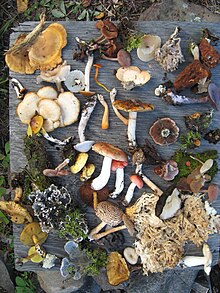biological diversity in an environment as indicated by number of different species of plants and animals.

Biodiversity is the biological variety and variability of life on Earth. Biodiversity is a measure of variation at the genetic, species, and ecosystem level. Terrestrial biodiversity is usually greater near the equator, which is the result of the warm climate and high primary productivity. Biodiversity is not distributed evenly on Earth, and is richer in the tropics. These tropical forest ecosystems cover less than ten percent of earth's surface, and contain about ninety percent of the world's species.Marine biodiversity is usually higher along coasts in the Western Pacific, where sea surface temperature is highest, and in the mid-latitudinal band in all oceans. There are latitudinal gradients in species diversity. Biodiversity generally tends to cluster in hotspots, and has been increasing through time, but will be likely to slow in the future as a primary result of deforestation.
Rapid environmental changes typically cause mass extinctions. More than 99.9 percent of all species that ever lived on Earth, amounting to over five billion species, are estimated to be extinct. Estimates on the number of Earth's current species range from 10 million to 14 million, of which about 1.2 million have been documented and over 86 percent have not yet been described. The total amount of related DNA base pairs on Earth is estimated at 5.0 x 1037 and weighs 50 billion tonnes. In comparison, the total mass of the biosphere has been estimated to be as much as four trillion tons of carbon). In July 2016, scientists reported identifying a set of 355 genes from the Last Universal Common Ancestor (LUCA) of all organisms living on Earth.
The age of the Earth is about 4.54 billion years. The earliest undisputed evidence of life on Earth dates at least from 3.5 billion years ago, during the Eoarchean Era after a geological crust started to solidify following the earlier molten Hadean Eon. There are microbial mat fossils found in 3.48 billion-year-old sandstone discovered in Western Australia. Other early physical evidence of a biogenic substance is graphite in 3.7 billion-year-old meta-sedimentary rocks discovered in Western Greenland. More recently, in 2015, "remains of biotic life" were found in 4.1 billion-year-old rocks in Western Australia. According to one of the researchers, "If life arose relatively quickly on Earth .. then it could be common in the universe."
Since life began on Earth, five major mass extinctions and several minor events have led to large and sudden drops in biodiversity. The Phanerozoic eon (the last 540 million years) marked a rapid growth in biodiversity via the Cambrian explosion—a period during which the majority of multicellular phyla first appeared. The next 400 million years included repeated, massive biodiversity losses classified as mass extinction events. In the Carboniferous, rainforest collapse led to a great loss of plant and animal life. The Permian–Triassic extinction event, 251 million years ago, was the worst; vertebrate recovery took 30 million years. The most recent, the Cretaceous–Paleogene extinction event, occurred 65 million years ago and has often attracted more attention than others because it resulted in the extinction of the non-avian dinosaurs.
The period since the emergence of humans has displayed an ongoing biodiversity reduction and an accompanying loss of genetic diversity. Named the Holocene extinction, the reduction is caused primarily by human impacts, particularly habitat destruction. Conversely, biodiversity positively impacts human health in a number of ways, although a few negative effects are studied.
The United Nations designated 2011–2020 as the United Nations Decade on Biodiversity. and 2021–2030 as the United Nations Decade on Ecosystem Restoration, According to a 2019 Global Assessment Report on Biodiversity and Ecosystem Services by IPBES 25% of plant and animal species are threatened with extinction as the result of human activity. An October 2020 IPBES report found the same human actions which drive biodiversity loss have also resulted in an increase in pandemics.
In 2020, the fifth edition of the UN's Global Biodiversity Outlook report, which served as a “final report card” for the Aichi Biodiversity Targets, a series of 20 objectives set out in 2010, at the beginning of the UN's Decade on Biodiversity, most of which were supposed to be reached by the end of the year 2020, stated that none of the targets – which concern the safeguarding of ecosystems, and the promotion of sustainability – have been fully met.
